Lab 3 - Structure from Motion
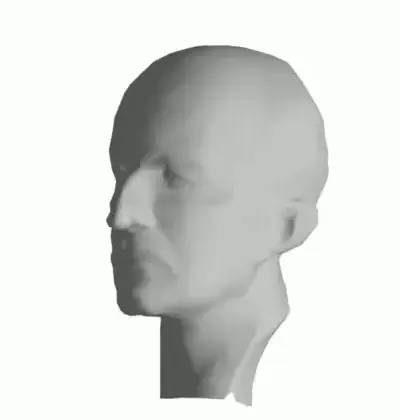
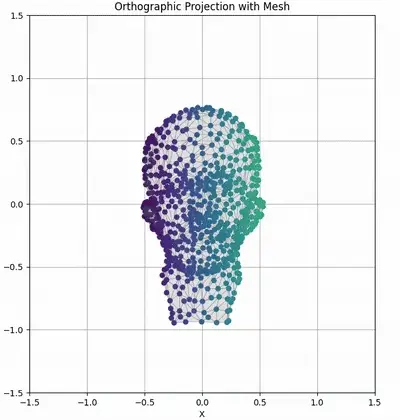
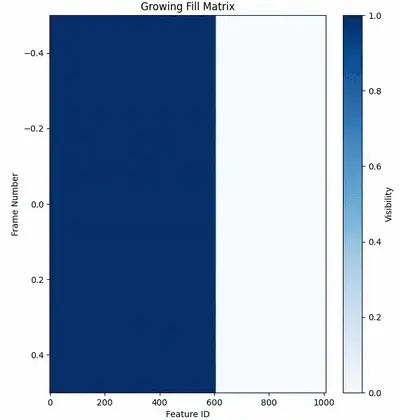
Middle: Sequence of tracked feature points on ground truth mesh viewed from an orthographic camera.
Right: Fill matrix visualization showing gradual accumulation of observations across frames (shaded entries are known image coordinates).
Overview
In this assignment you will implement an affine factorization method for structure from motion. You will then extend it to handle missing data (occlusions) via matrix completion, and perform a metric upgrade to recover the true Euclidean structure. You will test your implementation on provided datasets and on your own videos, and document your results with code, figures, and analysis.
Important: You can obtain 3 bonus marks for each section you finish and demo while present during the lab period we introduce the lab.
1: Affine Factorization Method (30)
Background: The affine factorization algorithm (described in Section 18.2 in Hartley & Zisserman, 2nd ed.) implements the Tomasi–Kanade method for Structure from Motion under an orthographic projection assumption.
The key insight is that when tracking \(P\) feature points across \(F\) frames (views), the resulting \(2F \times P\) measurement matrix will have rank 3 for a rigid scene under orthographic projection, after proper normalization (centering). This matrix can be factored into motion and shape matrices via Singular Value Decomposition (SVD).
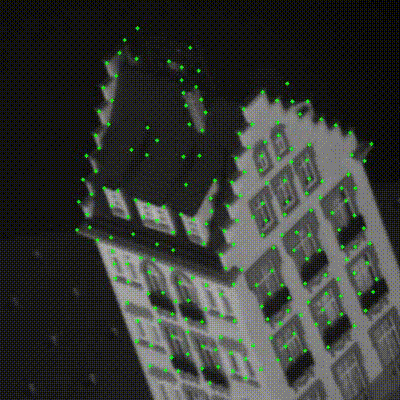
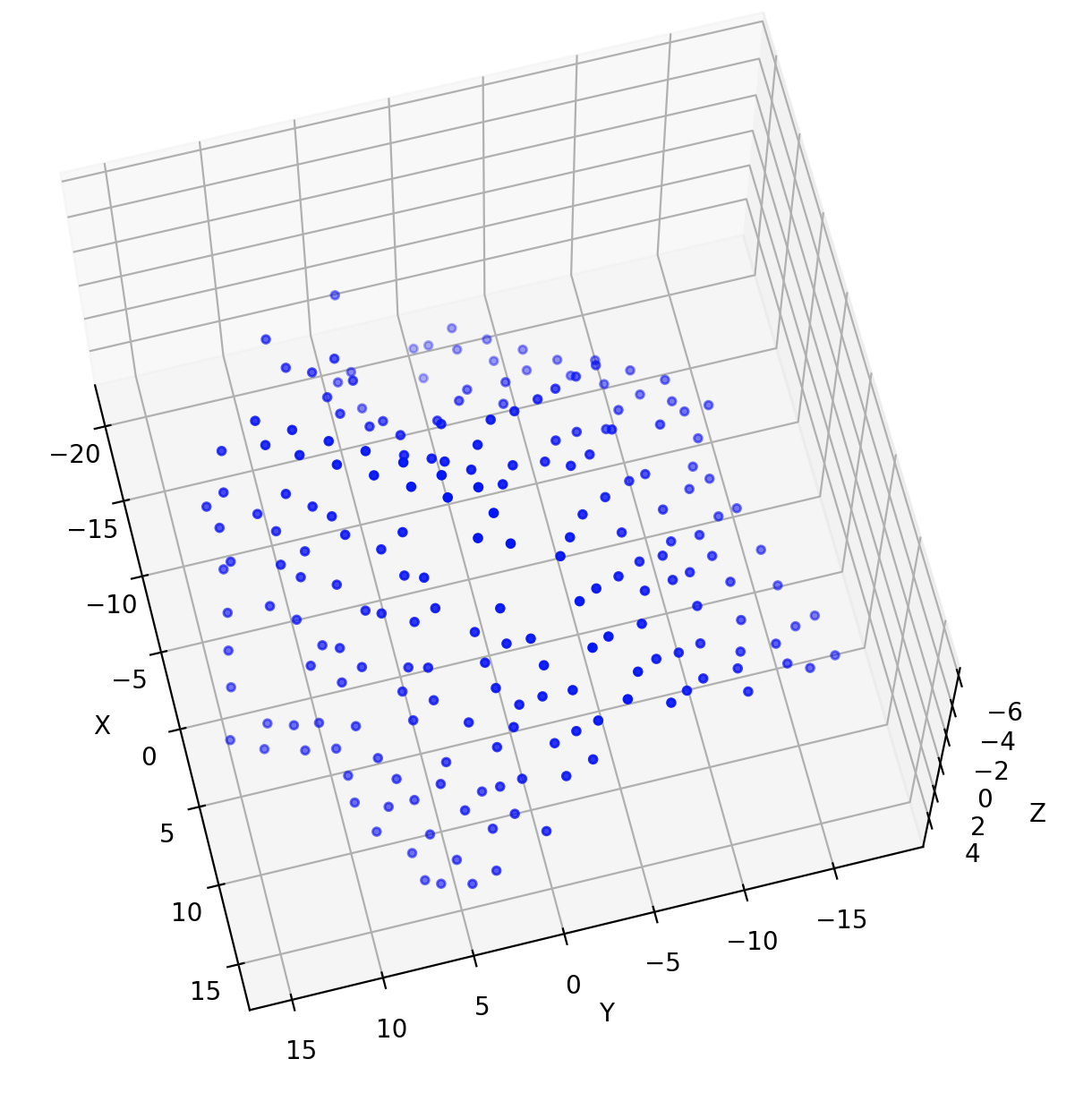
Right: Example of a 3D reconstruction output.
Task:
Implement the affine structure-from-motion algorithm following the procedure from Lecture 07 (slides 27–30) or the textbook on the following two datasets:
- The hotel dataset found here. In the zip, the measurement matrix can be found in the .txt.
- A short video you record yourself. You may use feature_tracker.py which finds good feature points, tracks them, and performs a global optimization to refine the tracking if you wish.
-
Form the measurement matrix \(W\) using tracked feature coordinates:
- Normalize the data by subtracting the mean from each row (i.e., each image’s \(x\) and \(y\) coordinates)
- This centering removes the translational motion and ensures \(W\) is of rank 3 in the noise-free case
-
Perform singular value decomposition: \(W \approx U \Sigma V^T\)
- Take the top 3 singular values and corresponding vectors (because the ideal rank is 3)
- Extract \(U_0\) (size \(2F \times 3\)), \(\Sigma_0\) (\(3 \times 3\)), and \(V_0\) (\(P \times 3\))
-
Factor into motion and shape matrices:
- Initialize the motion matrix as \(R = U_0 \Sigma_0^{1/2}\)
- Initialize the shape matrix as \(S = \Sigma_0^{1/2} V_0^T\)
At this point, \(W \approx R S\) gives an affine reconstruction of the cameras (in \(R\)) and 3D points (in \(S\)). Note that this reconstruction is not unique – any \(3 \times 3\) invertible transform \(Q\) gives an equivalent solution \(RQ\) and \(Q^{-1}S\).
Deliverables:
For each dataset (hotel and your own), save the following figures to include in your code submission and display them in your report:
- Plot the recovered 3D point cloud (obtained from \(S\))
Extra Tools and Resources:
- capture_motion.py is a python script that generates video data from a textured 3D mesh. Terminal inputs allow for control recording and the view of the model.
- Textured 3D models can be found here
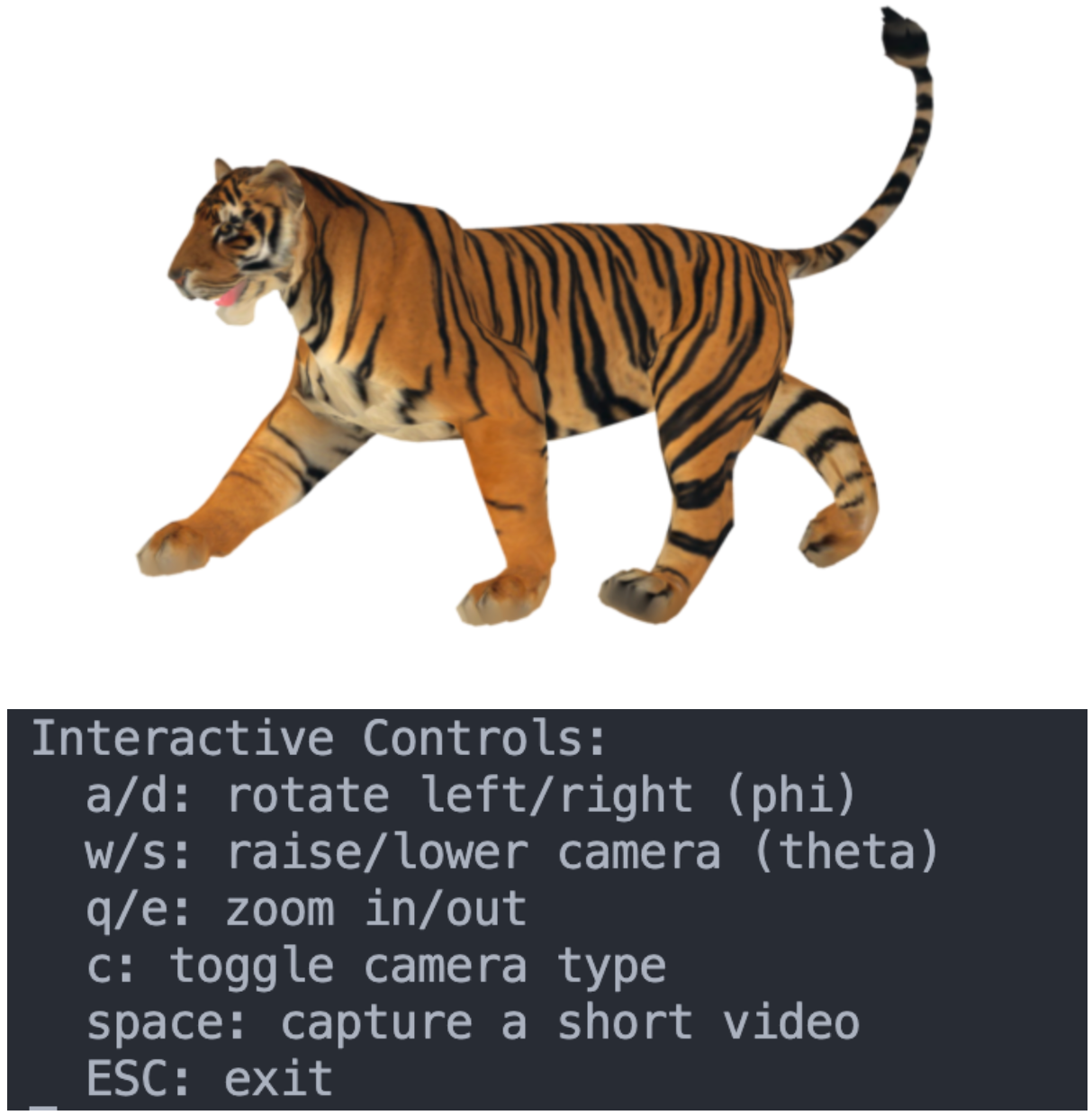
Report Question 1:
In your report, discuss what happens when applying this method to your own video data. Note that real cameras are projective, not orthographic, so your method might not perfectly reconstruct real video data. Analyze the differences and limitations you observe.
2: Metric Upgrade; Euclidean Reconstruction (30)
The factorization method you implemented in Part 1 yields a reconstruction that is affine – meaning it’s determined only up to an arbitrary linear transformation in 3D space. To recover the true Euclidean structure (up to a scale factor), we need to enforce that camera motions correspond to orthonormal rotations. This refinement process is known as the metric upgrade or affine to metric calibration.
In this question, you will implement the metric upgrade procedure to transform your affine reconstruction into a Euclidean one. You will then use a known scale factor between feature points to properly scale your reconstructed model to real-world dimensions.
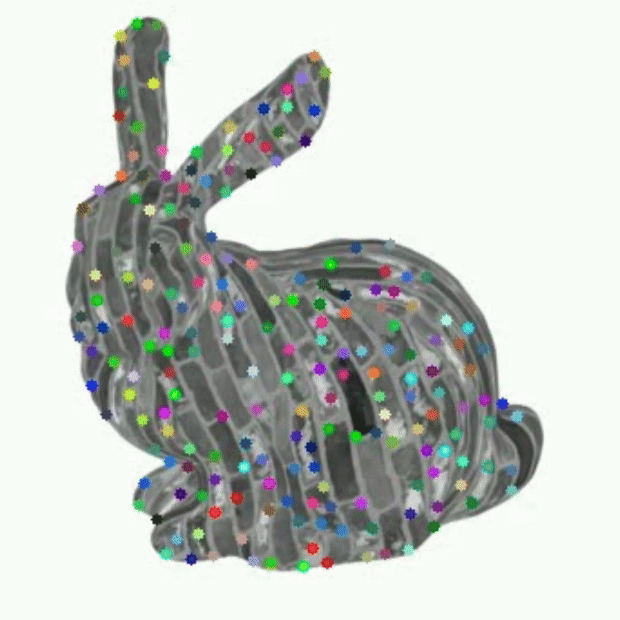
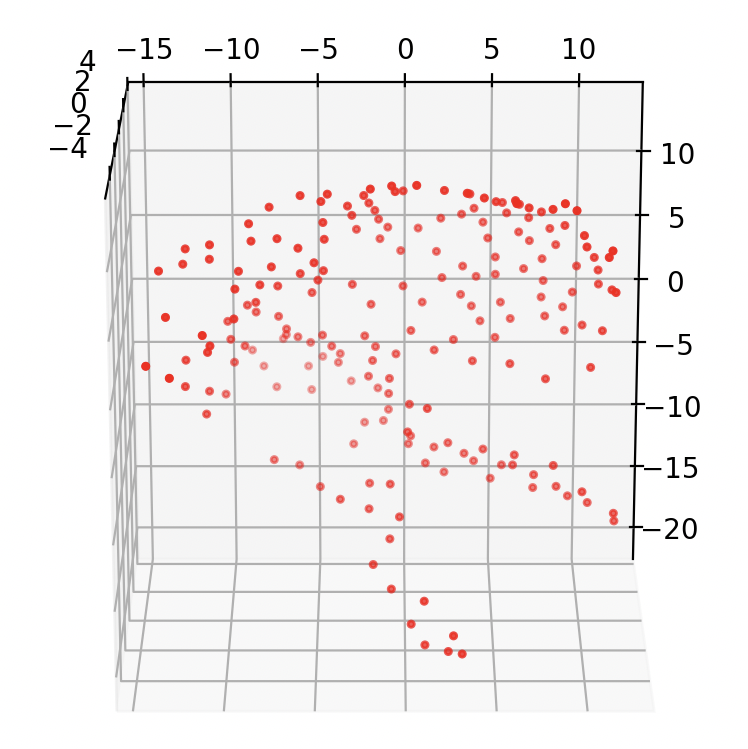
Right: Resulting Euclidean reconstruction.
a) Derive the Orthonormality Constraints
Suppose the \(i\)-th camera has affine motion represented by the two 3D row vectors \(r_{i1}\) and \(r_{i2}\) (from the \(R\) matrix). For a real rotation, we require: \(\begin{align} r_{i1} \cdot r_{i1}^T &= 1 \\ r_{i2} \cdot r_{i2}^T &= 1 \\ r_{i1} \cdot r_{i2}^T &= 0 \end{align}\) These constraints can be written in terms of the unknown metric upgrade matrix \(L = QQ^T\) (a symmetric \(3\times3\) matrix):
- For the first constraint: \(r_{i1} L r_{i1}^T = 1\)
- For the second constraint: \(r_{i2} L r_{i2}^T = 1\)
- For the third constraint: \(r_{i1} L r_{i2}^T = 0\)
Write out these equations for all cameras, resulting in at most \(3F\) equations (3 per frame) for the 6 independent entries of \(L\) (since \(L\) is symmetric).
b) Solve for the Upgrade Matrix
Arrange the constraints into a linear system \(AL = b\) where:
- \(A\) is a matrix containing coefficients from the constraints
- \(L\) is a vector of the 6 independent entries of the symmetric matrix \(L\)
- \(b\) is a vector with entries 1, 1, 0, … for each camera’s constraints
Solve this system using linear least-squares to find the \(L\) that best satisfies all equations.
c). Compute the Upgrade Transformation
Once you have \(L \approx QQ^T\):
- Perform a Cholesky decomposition or eigen-decomposition to obtain \(Q\)
- You may need to create a positive definite approximation if \(L\) has negative or zero eigenvalues due to noise
- One approach is to perform eigen-decomposition, set any negative eigenvalues to a small positive value, and reconstruct \(L\)
- Apply \(Q\) to the affine reconstruction to get the Euclidean reconstruction:
Now \(R_{\text{euclid}}\) should represent valid rotation matrices (scaled) and \(S_{\text{euclid}}\) is the structure in Euclidean space (up to an overall scale factor).
d) Apply Absolute Scale Calibration
To obtain a model with real-world dimensions, you need to use known physical measurements between feature points. Use The figure below to calibrate the scale of your Hotel reconstruction from Part 1:
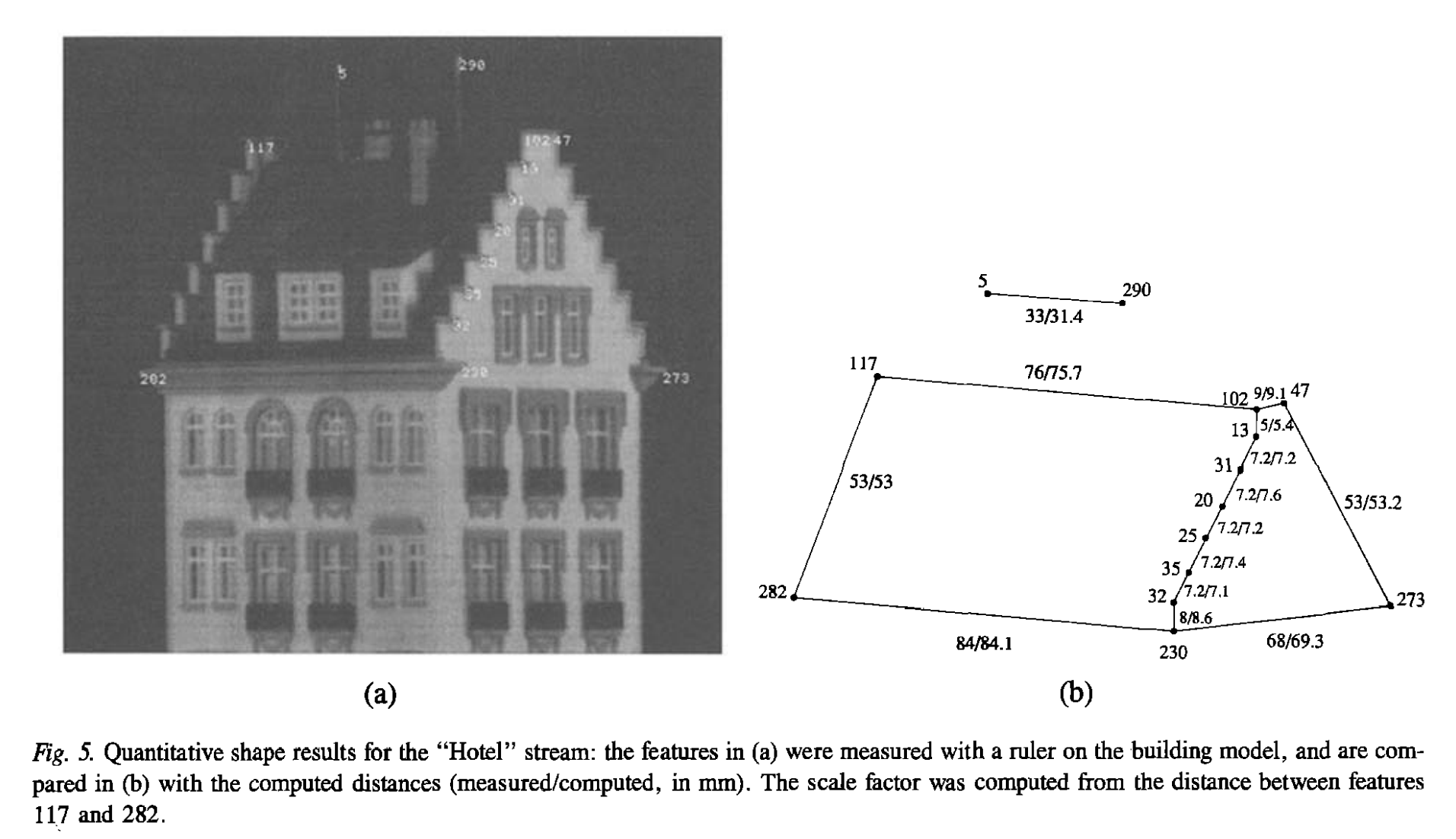
- Identify reference points: Select two or more feature points in your reconstruction where you know the actual physical distance between them. For example:
-
Compute the scale factor:
- Let \(d_{real}\) be the known real-world distance between your reference points
- Let \(d_{recon}\) be the corresponding distance in your reconstructed model
- The scale factor is then \(s = d_{real} / d_{recon}\)
-
Apply the scale:
- Scale your Euclidean reconstruction: \(S_{scaled} = s \times S_{euclid}\)
-
Verification:
- Measure other known distances in your scaled model to verify the accuracy
Your final scaled reconstruction should now have proper real-world dimensions, allowing for ‘accurate’ measurements and integration with other 3D models or systems.
Bonus (10) - Metric upgrade on your own data
- Perform the same metric upgrade on your own video (this can be the same video you captured for Question 1). Include the 3D metric reconstruction in your code submission and report, and evaluate its accuracy
Deliverables:
Using the provided Hotel data, save the following figures to include in your code submission and display them in your report:
- Plot the recovered 3D point cloud (obtained from \(S\))
- Visualize the camera positions (obtained from \(R\)) in 3D
- Evaluate its accuracy
Report Question 2:
Visualize the 3D reconstruction before and after the metric upgrade. Analyze, using your own methods, how the metric upgrade affects the quality of the reconstruction. How good are your between reconstructed distances compaird to the known distances?
3: Handling Missing Data; Matrix Completion (40)
In practice, not all feature points are visible in all frames – points may disappear due to occlusion or tracking loss. The basic factorization method in part 1 & 2 requires a complete measurement matrix, so we want to extend it to handle missing entries.
The approach you will implement is based on Tomasi and Kanade’s paper “Shape and Motion from Image Streams under Orthography: A Factorization Method” (IJCV 1992), which proposes an iterative strategy to handle occlusions. The idea is to start with initial estimates for the missing values, factorize the matrix, and then gradually refine the estimates by leveraging the low-rank structure of \(W\).
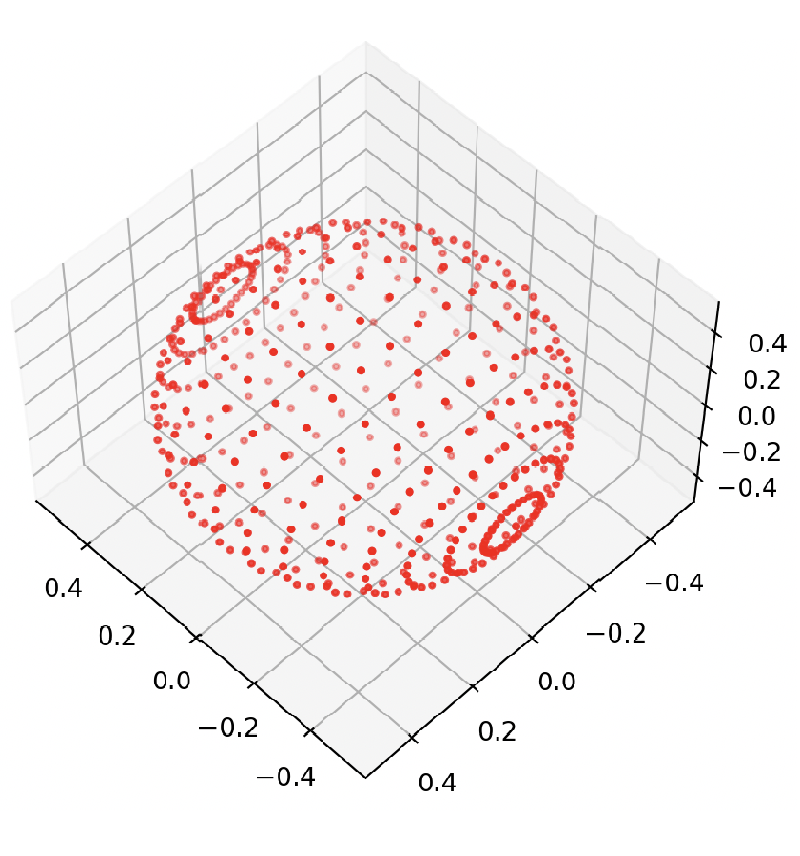
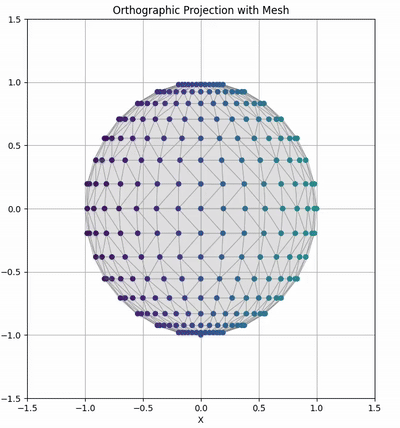
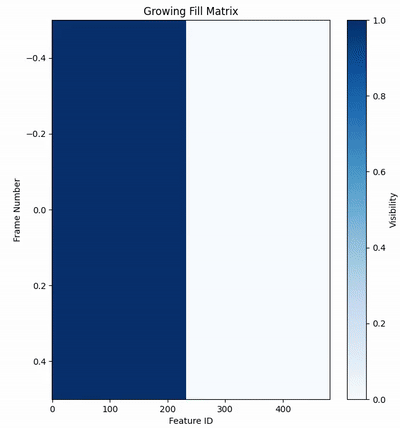
Middle: Orthographic image sequence.
Right: Fill matrix visualization showing gradual accumulation of observations across frames (shaded entries are known image coordinates).
Key concept: Define a fill matrix (or mask matrix) of the same size as \(W\), with entries:
- 1 for observed measurements
- 0 for missing ones The fill matrix lets us compute errors or updates only on observed entries while ignoring missing ones during the optimization process.
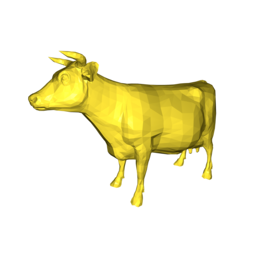
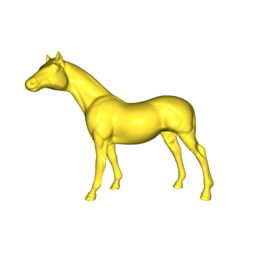
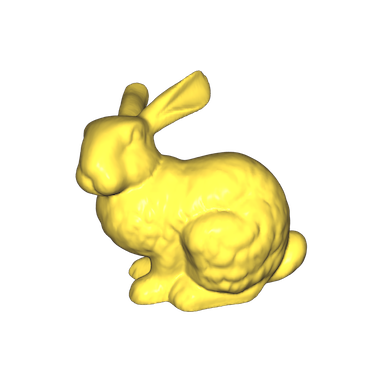
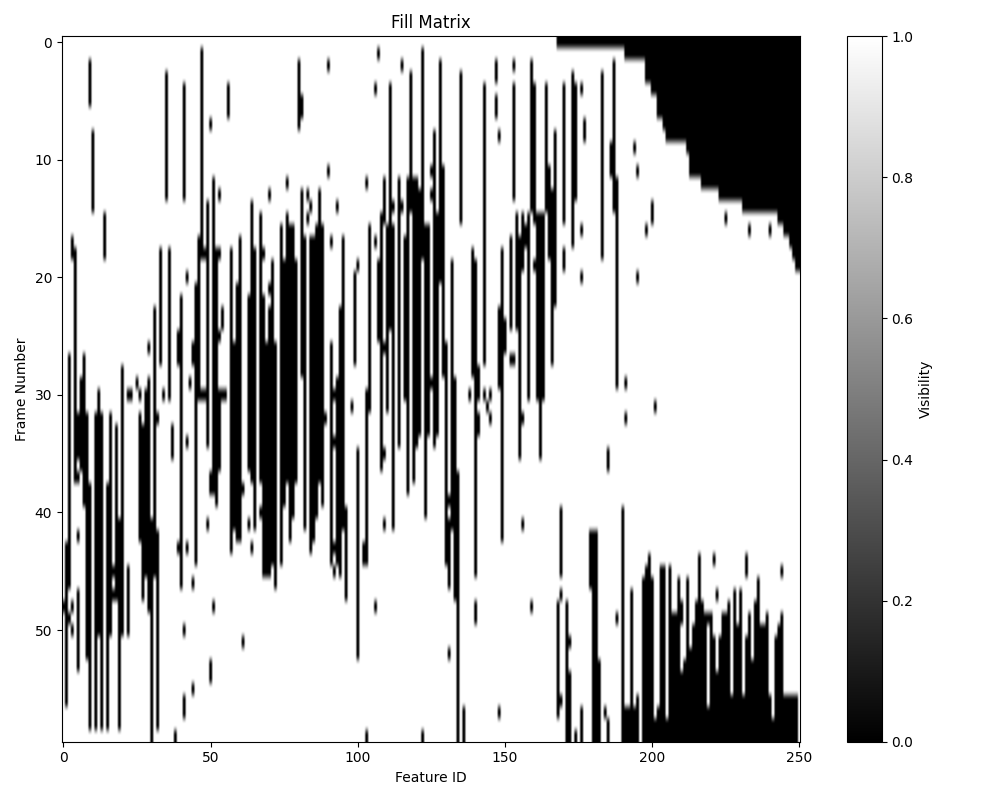

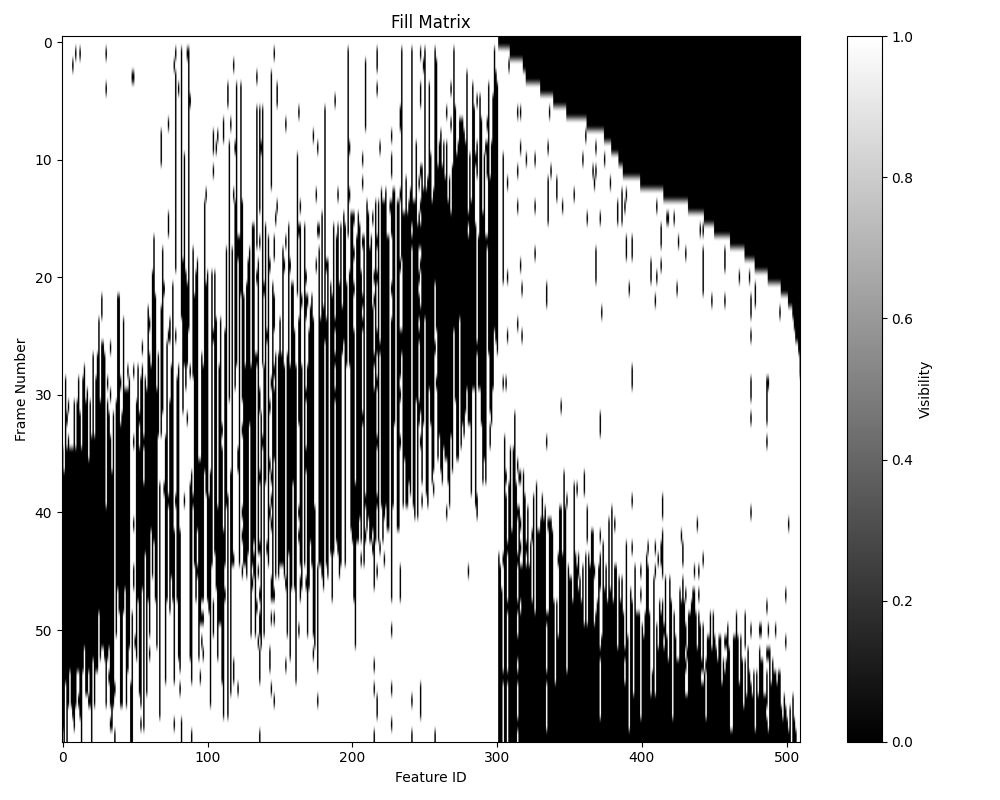
Task:
Implement matrix completion for Structure from Motion using the iterative factorization approach:
-
Initialize missing entries in the measurement matrix:
- For each point with missing observations, fill in the gaps with reasonable estimates (e.g., the mean of that point’s observed projections across frames)
- Center the data by removing per-camera translation (row-wise centering)
-
Perform initial factorization using SVD to obtain rank-3 approximation:
- Decompose the filled measurement matrix into motion matrix \(M\) and shape matrix \(S\)
-
Iterative refinement:
- Project the current estimates to reconstruct the measurement matrix: \(W_{recon} = M \times S\)
- Replace the reconstructed values at known positions with the original measurements (using the fill matrix)
- Re-factorize using SVD to obtain updated \(M\) and \(S\)
- Compute reconstruction error over known entries
- Repeat until convergence or maximum iterations reached
-
Metric upgrade:
- Enforce orthonormality constraints on the camera rows
- Apply the appropriate transformation to recover the motion and shape matrices
Bonus (10) - Meshing
- Mesh your resulting 3D point cloud and include it in your code submission and report. Describe the meshing algorithm you implemented or library you utilized (e.g., Ball-Pivoting, Poisson Surface Reconstruction, Alpha Shapes). Explain why you selected this particular meshing approach and its suitability for the structure-from-motion point clouds.
Deliverables:
First test your implementation on the sphere dataset and then evaluate it on the Cow, Horse, and Stanford Bunny datasets.
Repeat the following for each dataset and include each figure in your code submission and report:
- Plot the recovered 3D point cloud (obtained from \(S\))
- Visualize the camera positions/orientations (obtained from \(R\)) in 3D
Extra Tools and Resources:
- More 3D models can be obtained here.
- You may use mesh_experiment.py to load a mesh and track points from an orthographic camera which will then output a measurement matrix and a fill matrix.
Report Question 3:
- Analyze the quality of each of the reconstructions you achieved.
- Why can't we directly apply SVD to a matrix with missing entries?
- How does the low-rank assumption allow us to recover missing values?
- Explain the role of the fill matrix in computing reprojection error or updates.
- Compare the convergence behavior for different datasets. How many iterations were needed? Did the error decrease smoothly?
Submission Details
- Include accompanying code used to complete each question. Ensure they are adequately commented.
- Ensure all functions are and sections are clearly labeled in your report to match the tasks and deliverables outlined in the lab.
- Organize files as follows:
-
code/folder containing all scripts used in the assignment. -
media/folder for images, videos, and results.
-
- Final submission format: a single zip file named
CompVisW25_lab3_lastname_firstname.zipcontaining the above structure. - Your report for Lab 3 is to be submitted at a later date. The report contains all media, results, and answers as specified in the instructions above. Ensure your answers are concise and directly address the questions.
- Total marks for this lab is 100 for all students. Your lab assignment grade with bonus marks is capped at 130%.